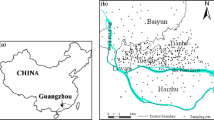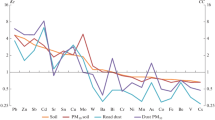Abstract
The ambient PM10 and background soil samples were collected and analyzed with ICP-AES in eight cities around China to investigate the levels of ten heavy metals (Ti, V, Cr, Mn, Fe, Co, Ni, Cu, Zn, and Pb). The mean concentrations of ten heavy metals in PM10 of the eight cities of China followed the order of Zn > Pb > Mn > Cu > Ni > Cr > Co > V. The metals in the ambient PM10 and soil were compared in each city to evaluate the heavy metal mass fraction from anthropogenic sources in ambient air. The CD values in these cities were all above 0.2, indicating that the ingredients spectrums of PM10 and soil vary markedly. Most heavy metals were enriched in PM10, except Fe and Ti. The results showed that almost all the cities suffer important heavy metal pollution from anthropogenic sources. The eight cities were also grouped according to their similarity in heavy metals of ambient PM10 by cluster analysis to investigate the relationship between the heavy metals and the pollution sources of each city. The conclusion was that the eight cities were divided into three clusters which had similar industrial type and economy scale: the first cluster consisted of Shenzhen, Wuxi, and Guiyang; followed by Jinan and Zhengzhou as the second grouping; and the third group had Taiyuan, Urumqi, and Luoyang.




Similar content being viewed by others
References
Al-Khashman, O. A. (2004). Heavy metal distribution in dust, street dust and soils from the work place in Karak Industrial Estate, Jordan. Atmospheric Environment, 38, 6803–6812.
Anderberg, R. (1973). Cluster analysis for applications. New York: Academic Press.
Bi, X. H., Feng, Y. C., & Wu, J. H. (2007). Source apportionment of PM10 in six cities of northern China. Atmospheric Environment, 41, 903–912.
Chen, T. B., Zheng, Y. M., Chen, H., & Zheng, G. D. (2004). Background concentrations of soil heavy metals in Beijing. Environmental Science, 25(1), 117–122.
Clark, P. J. (1952). Copeia, 2, 61.
Directive 2008/50/EC. Directive 2008/50/EC of the European Parliament and of the Council of 21 May 2008 on ambient air quality and cleaner air for Europe.
EPA. (1997). EPA’s Office of Air Quality Planning and Standards (National Ambient Air Quality Standards). Washington: Environmental Protection Agency.
Faruque, A., & Hiroaki, I. (2006). Trace metal concentrations in street dusts of Dhaka city, Bangladesh. Atmospheric Environment, 40, 3835–3844.
Feng, Y. C., Peng, L., Wu, J. H., Zhu, T., Lv, A. H., & Zhang, K. T. (2005). Analytic studies on source of TSP and PM10 in environmental air of Urumqi city. China Environmental Science, 25(Suppl), 30–33.
Fernández Espinosa, A. J., Rodriguez, M. T., Barragán de la Rosa, F. J., & Jiménez Sánchez, J. C. (2002). A chemical speciation of trace metals for fine urban particles. Atmospheric Environment, 36, 773–780.
Han, B., Feng, Y. C., Bi, X. H., Xue, Y. C., Wu, J. H., Zhu, T., Ding, J. Q., & Du, Y. X. (2009). Source apportionment of acccmbient PM10 in urban area of Wuxi city. Research of Environmental Sciences, 22(1), 35–39.
Hopke, P. K., Gladney, E. S., Gordon, G. E., Zoller, W. H., & Jones, A. G. (1976). Atmospheric Environment, 10, 1015.
Horckmansa, L., Swennena, R., Deckersb, J., & Maquilc, R. (2005). Local background concentrations of trace elements in soils: a case study in the Grand Duchy of Luxembourg. Catena, 59(3), 279–304.
Hu, W., & Wei, F. S. (2002). Comparison of elements in particulate matters in air of partial cities in China. Shanghai Environmental Sciences, 21(7), 408–411.
Huang, N. (2009). The evolution and current status of industrial structure in Nanjing since the opening-up. Social Science in Nanjing, 1, 121–127.
Huang, S. S., Tu, J., Liu, H. Y., Hua, M., Liao, Q. L., Feng, J. S., Weng, Z. H., & Huang, G. M. (2009). Multivariate analysis of trace element concentrations in atmospheric deposition in the Yangtze River Delta, East China. Atmospheric Environment, 43(36), 5781–5790.
Iijima, A. (2001). Trace elements in airborne particulate matter: sources identification and seasonal variation. M. Sc. Thesis, Chuo University, Tokyo, Japan.
Ji, Y. Q. (2006). Study on the soil dust profiles for source apportionment of ambient particulate matter. Tianjin: Nankai University.
Johnson, R. A., & Wichern, D. W. (1992). Applied multivariate statistical analysis (3rd ed.). New Jersey: Prentice Hall.
Kim, K. H., Mishra, V. K., Kang, C. H., Choi, K. C., Kim, Y. J., Kim, D. S., Youn, Y. H., & Lee, J. H. (2005). The metallic composition of aerosols at three monitoring sites in Korea during winter 2002. Environmental Monitoring and Assessment, 121, 381–399.
Liang, Y., Liu, X. Z., Peng, X. L., Tang, X. H., & Wang, Y. H. (2010). Research on pollution characteristic of heavy metal in the atmospheric particles of Nanchang City. Science Mosaic, 8, 150–154.
Liu, Y. Q., Han, C. Z., Jin, L. C., Jing, L. J., & Zhang, H. W. (2009). Contents and distribution characteristic of heavy metal in atmospheric particulate of Tumen City. Environmental Monitoring in China, 25(2), 63–66.
Lu, X. Y., & Hu, B. Y. (2007). A study on the correlation between industry structure and employment structure in Chengdu. Science Technology and Industry, 7(8), 8–10.
Murillo, J. H., & Marín, J. F. R. (2010). Concentration of PM10 in the metropolitan area of Costa Rica, Central America: chemical composition and potential sources. Atmosfera, 23(4), 307–323.
Querol, X., Viana, M., Alastuey, A., et al. (2007). Source origin of trace elements in PM from regional background, urban and industrial sites of Spain. Atmospheric Environment, 41, 7219–7231.
Rhodes, A. M., Carmer, S. G., & Courter, J. W. (1969). Journal of the American Society for Horticultural Science, 94, 98–102.
SEPA (1996). Ambient air quality standard, GB 3095–1996.
Showan, J. N. (2005). Study of particulate matter (PM 10 ) in air in Taiyuan, Shanxi. China: University of OSLO.
Sternbeck, J., Åke, S., & Andréasson, K. (2002). Metal emissions from road traffic and the influence of resuspension—results from two tunnel studies. Atmospheric Environment, 36, 4735–4744.
Sun, Y., Zhuang, G. S., Wang, Y., Han, L. H., Guo, J. H., Dan, M., Zhang, W. J., Wang, Z. F., & Hao, Z. P. (2004). The air-borne particulate pollution in Beijing concentration, composition, distribution and source. Atmospheric Environment, 38, 5991–6004.
TobÍas, F. J., Bech, J., & Sánchez, P. (1997). Establishment of the background levels of some trace elements in soils of NE Spain with probability plots. Science of the Total Environment, 206, 255–265.
Tursun, Y., Talifu, D., Ablizi, A., & Ma, L. (2010). Pollution level of heavy metals in PM2.5 and PM10−2.5 during winter in Urumqi. Journal of Xinjiang University (Natural Science Edition), 27(3), 338–342.
Wang, J., Wang, C., & Chen, Z. L. (2011). Heavy metal pollution of PM10/PM2.5 near-surface in Guiyang. Environmental Science and Technology, 34(4), 74–76.
Watson, J. G., & Chow, J. C. (1993). Ambient air sampling. In K. Willeke & P. A. Baron (Eds.), Aerosol measurement: principles, techniques and applications (pp. 622–639). New York: Van Nostrand, Reinhold.
WHO. (2000). Air quality guidelines for Europe (2nd ed.). Copenhagen: WHO.
Willers, S., Gerhardsson, L., & Lundh, T. (2005). Environmental tobacco smoke (ETS) exposure in children with asthma-relation between lead and cadmium, and cotinine concentrations in urine. Respiratory Medicine, 99, 1521–1527.
Wongphatarakul, V. M. S. (1997). Thesis in Chemical Engineering, UCLA.
Wongphatarakul, V., Friedlander, S. K., & Pinto, J. P. (1998). A comparative study of PM2.5 ambient aerosol chemical databases. Environmental Science and Technology, 32(24), 3926–3934.
Xie, H. L., Zhang, P., He, H., & Jiang, H. W. (2002). Distribution of heavy metal elements in the different diametral atmospheric particulate matters. Environmental Engineering, 20(6), 55–57.
Xu, H. (2011). Effect of ambient air particulate matter on precipitation acidity. Tianjin: Nankai University.
Zhang, Y. L. (2009). The industrial structure research of Taiyuan Economic Circle. Taiyuan: Zhong Bei University.
Zhang, Z. Q., & Friedlander, S. K. (2000). A comparative study of chemical databases for fine particle Chinese aerosols. Environmental Science and Technology, 34(22), 4687–4694.
Zhou, X., & Xia, B. C. (2010). Defining and modeling the soil geochemical background of heavy metals from the Hengshi River watershed (southern China): integrating EDA, stochastic simulation and magnetic parameters. Journal of Hazardous Materials, 180, 542–551.
Zhu, Z. C., Kong, L. L., & Xia, K. (2009). Analysis of PM10 source in Wuhan and its countermeasures. Environmental Science and Technology, 32(9), 64–67.
Acknowledgments
This study was founded by Basic Science Research foundation of Nankai University.
Author information
Authors and Affiliations
Corresponding author
Rights and permissions
About this article
Cite this article
Wang, Q., Bi, XH., Wu, JH. et al. Heavy metals in urban ambient PM10 and soil background in eight cities around China. Environ Monit Assess 185, 1473–1482 (2013). https://doi.org/10.1007/s10661-012-2646-5
Received:
Accepted:
Published:
Issue Date:
DOI: https://doi.org/10.1007/s10661-012-2646-5




